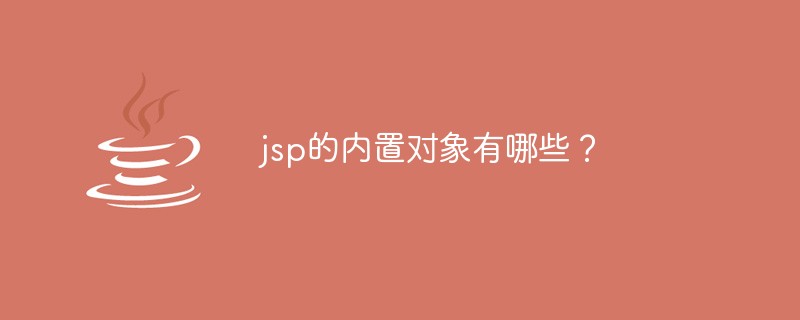What are the built-in objects of jsp?
- 青灯夜游Original
- 2020-11-09 11:30:395942browse
The built-in objects of jsp are: request object, response object, session object, out object, application object, page object, exception object, pageContext object, and config object.

Related recommendations: "Java Video Tutorial"
JSP (Java Server Page) is to simplify Alternatives that have emerged to work with Servlets. Sun launched ServletAPI and the first Java Web server in 1997. In the early Java web layer architecture, there were only Servlets. Accepting user requests, processing business logic, and generating HTML display results are all completed in Servlets. Although Servlet can do all the work, Servlet cannot embed HTML code like PHP, ASP, etc. It is difficult to output HTML, and the deployment process is also complicated.
The built-in objects of JSP refer to the Java objects that have been built-in by default in the JSP page system. These objects can be used without explicit declaration by developers. In the JSP page, you can achieve mutual access with the JSP page and the Servlet environment by accessing the JSP built-in objects. Each internal object has a corresponding ServletAPI type.
What are the built-in objects of jsp?
JSP built-in objects include request object, response object, session object, out object, application object, page object, exception object, pageContext object, and config object. These objects perform different functions during the interaction between the client and the server.
1.Request object
The Request object is an instance of the javax.servlet.http.HtupServletRequest class. Represents the request object, mainly used to accept data transmitted from the client to the server through the HTTP protocol connection. For example, the data in the form, the parameters after the web page address, etc.
2.Response object
The Response object is an instance of the javax.servlet.http.HttpServletResponse class. Represents a response object, mainly used to send data to the client.
3.Out object
The Out object is an instance of the javax.servletjspjspWriter class. Mainly used to output data to the client browser.
4.session object
The Session object is an instance of the javax.servlet.htp.Http session class. It is mainly used to maintain data that needs to be retained between the server and a client, such as maintaining the user's login information during the session. Session state maintenance is a problem that web application developers must face. When the client closes all web pages of the website or closes the browser, the data saved in the session object will be automatically cleared. Since the Htp protocol is a stateless protocol and does not retain data between sessions, the functions of Htp are extended through the session object. For example, after a user logs into a website, the login information will be temporarily saved in the session object. When opening different pages, the login information can be shared. Once the user closes the browser or logs out, the login information saved in the session object will be cleared.
5.Application object
The Application object is an instance of the javax.servlet.ServletContext class. It is mainly used to save user information and the running environment of code snippets; it is a shared built-in object, that is, multiple users in a container share an application object, so the information it saves is shared by all users.
6.PageContext object
The PageContext object is an instance of the javax.servlet.jsp.PageContext class. It is used to manage web page attributes, wrap the page context for JSP pages, and manage access to named objects belonging to special visible parts of JSP. Its creation and initialization are completed by the JSP container.
7.Config object
The Config object is an instance of the javax.servlet.ServletConfig class. It is a code snippet configuration object, representing the configuration of the Servlet.
8.Page (equivalent to this) object
The Page object is an instance of the javax.servlet.jsp.HttpJspPage class. Used to process JSP web pages, it refers to the JSP page object itself, or represents the compiled servlet object, which is legal only within the scope of the JSP page.
9.Exception object
Exception object is an instance of java.lang.Throwable class. To handle errors and exceptions that occur during JSP file execution, the exception object can be used on this page only after specifying isErrorPage="true" in the page directive of the JSP page.
It should be noted that the attributes in the pageContext are shared on the current page by default; the attributes in the session are shared on the current session; the attributes in the application object are shared on all pages.
For more programming-related knowledge, please visit: Introduction to Programming! !
The above is the detailed content of What are the built-in objects of jsp?. For more information, please follow other related articles on the PHP Chinese website!

